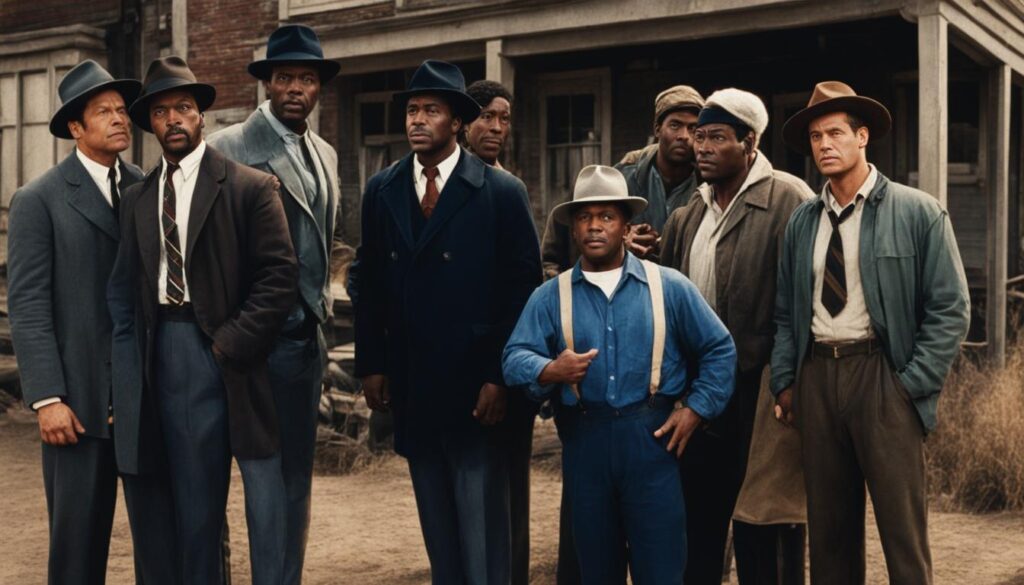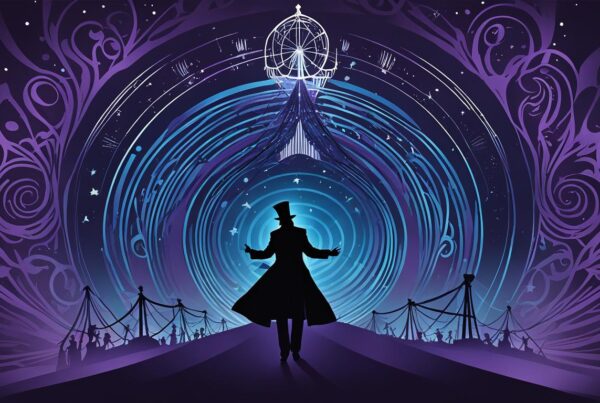In this audiobook review, we explore “The Nickel Boys” by Colson Whitehead, a powerful and poignant story that has captivated audiences since its publication.
Winner of the Pulitzer Prize and named one of TIME magazine’s 10 best books of 2019, “The Nickel Boys” delves into themes of racial injustice, resilience, and friendship, showcasing the unforgettable journey of two young boys in the Jim Crow South.
Key Takeaways
- “The Nickel Boys” is a Pulitzer Prize-winning book by Colson Whitehead.
- The book explores themes of racial injustice, resilience, and friendship in the Jim Crow South.
- The audiobook performance brings the story to life with exceptional narration and production quality.
- The book has received critical acclaim, including recognition from TIME as one of the top 10 books of 2019.
- “The Nickel Boys” is a powerful and relevant story that resonates with contemporary issues surrounding social justice and systemic racism.
Overview of “The Nickel Boys”
Experience the heart-wrenching tale of “The Nickel Boys” by Colson Whitehead. The novel follows the story of two black boys, Elwood and Turner, grappling with the injustices of the Jim Crow era in Florida.
The plot revolves around the Nickel Academy, a reformatory school for young boys, where they endure physical and mental abuse at the hands of their white educators. The story alternates between Elwood and Turner’s perspectives, revealing their struggles to survive in a racist and oppressive society.
Themes
- Racial Injustice
- Resilience
- Friendship
Colson Whitehead brilliantly explores themes of racial injustice, resilience, and the power of friendship in “The Nickel Boys.” The novel is a poignant reminder of the struggles that black Americans endured during the Jim Crow era, shedding light on the dark and painful history of the United States.
Characters
| Character | Description |
|---|---|
| Elwood Curtis | A smart and ambitious young black boy who believes in the promise of the Civil Rights movement. |
| Turner | A cynical and streetwise boy who becomes Elwood’s friend at Nickel Academy. |
| Griffin | The sadistic and racist white leader at Nickel Academy. |
| Mr. Hill | A kind and compassionate teacher at Nickel Academy who tries to help Elwood. |
Whitehead creates complex and multifaceted characters in “The Nickel Boys,” bringing to life the struggles and triumphs of Elwood, Turner, and other characters who suffer under the Jim Crow system.
Colson Whitehead: The Author Behind the Book
Colson Whitehead is an American novelist, essayist, and playwright known for his thought-provoking works that dive deep into complex themes and topics. Born in New York City in 1969, Whitehead attended Harvard University and then worked as a journalist before pursuing a full-time career in writing.
Whitehead has authored numerous works, including seven novels and two books of non-fiction. He first gained widespread recognition for his novel “The Intuitionist,” which was a finalist for the PEN/Hemingway Award and a recipient of the Quality Paperback Book Club’s New Voices Award. He followed this success with “John Henry Days,” which won the Young Lions Fiction Award and the Anisfield-Wolf Book Award. In 2016, his novel “The Underground Railroad” won the Pulitzer Prize for Fiction, the National Book Award for Fiction, and the Carnegie Medal for Excellence, among numerous other honors.
One of the hallmarks of Whitehead’s writing is his unique style, which blends realism with elements of the fantastical and surreal. He often explores themes related to social justice and inequality, drawing on his own experiences and those of the wider community to craft narratives that are both engaging and thought-provoking.
With “The Nickel Boys,” Whitehead once again demonstrates his prowess as a writer, crafting a powerful narrative that sheds light on the deep-seated injustices of a bygone era while also speaking to contemporary issues of social justice and systemic racism.
Audiobook Performance
Experience the enthralling story of “The Nickel Boys” in a whole new way with its audiobook performance. The narration by JD Jackson is exceptional, drawing listeners into the emotionally charged story with his authentic and nuanced delivery. Jackson’s voice acting brings the characters to life, creating a vivid and immersive experience for the listener.
In addition to the superb narration, the production quality of the audiobook is also impressive. The audio is clear and well-balanced, providing a seamless listening experience. The use of music and sound effects enhances the emotional impact of the story without overpowering the narration.
Overall, the audiobook of “The Nickel Boys” delivers a powerful and engaging performance that does justice to Colson Whitehead’s compelling narrative.
Themes Explored in “The Nickel Boys”
The Nickel Boys is a powerful work of fiction that explores a variety of themes including racial injustice, resilience, and friendship. These themes are deftly woven throughout the narrative, providing a thoughtful and impactful reading experience.
The novel tackles the issue of racial injustice head-on, exploring the devastating impact of systemic racism on individuals and communities. Through the experiences of the main character, Elwood Curtis, and others at the Nickel Academy, readers are exposed to the harsh realities of life under Jim Crow laws. The book forces readers to confront uncomfortable truths about America’s past and the present reality of racial inequality.
Despite the heavy subject matter, The Nickel Boys also explores themes of resilience and determination. Elwood and his friend Turner refuse to be beaten down by the injustice they face, and instead use their experiences to inspire change and fight for a better future. Through their struggles, the book reminds readers of the strength of the human spirit and the power of hope in even the darkest of circumstances.
The bonds of friendship are also a central theme in the novel, with the relationship between Elwood and Turner serving as a powerful example of the support and connection that can be found even in difficult times. As the two navigate the challenges of life at the Nickel Academy, their friendship serves as a beacon of light and hope amidst the darkness.
The Nickel Boys is a book that encourages readers to reflect on their own experiences and engage with the complex issues that it explores. Through its exploration of themes like racial injustice, resilience, and friendship, the novel offers a thought-provoking and poignant examination of the human condition.
Character Development in “The Nickel Boys”

The character development in “The Nickel Boys” is a standout element of the novel. Colson Whitehead skillfully crafts complex and dynamic characters that evolve throughout the story. Elwood Curtis, the main protagonist, undergoes a profound transformation as he navigates the harrowing experiences at Nickel Academy.
At the start of the novel, Elwood is an optimistic and hopeful young man with a passion for learning and a belief in the power of education. However, as he begins to understand the true horrors of Nickel Academy, his belief in the justice system and in humanity as a whole is challenged.
Turner, Elwood’s friend and fellow Nickel Academy student, is another character who undergoes significant development. Initially, he is cynical and jaded, having already experienced the harsh realities of the facility. However, his relationship with Elwood and the events that unfold gradually begin to soften his outlook.
The supporting characters in “The Nickel Boys” also play an important role in the character development of Elwood and Turner. Through their interactions with these characters, we gain insight into the broader themes of the novel, including the impact of systemic racism on individual lives.
Progression of Elwood and Turner
| Elwood | Turner | |
|---|---|---|
| Beginning of Novel | Optimistic, idealistic | Cynical, resigned |
| Midpoint | Experiences betrayal, begins to lose hope | Forms bond with Elwood, starts questioning his worldview |
| End of Novel | Radically transformed, disillusioned but determined | Has softened outlook, develops a deeper sense of empathy |
Overall, the character development in “The Nickel Boys” is a testament to Colson Whitehead’s skill as a writer and his ability to create multi-dimensional characters that resonate with readers long after the story has ended.
Writing Style and Narrative Structure
Colson Whitehead’s writing style in “The Nickel Boys” is characterized by its use of vivid prose and powerful storytelling techniques. With careful attention to detail, he crafts a gripping narrative that effortlessly captures the reader’s attention and holds it until the very end.
One of the most notable aspects of Whitehead’s writing is his use of a nonlinear narrative structure. Rather than telling the story in a straightforward, chronological manner, he weaves together different points in time to create a more complex and nuanced portrait of his characters and their experiences.
This narrative technique adds depth and dimension to the story, allowing Whitehead to explore complex themes of race, justice, and resilience in a more nuanced way. It also keeps the reader engaged and intrigued, as they piece together different parts of the story and try to anticipate what will happen next.
Throughout the book, Whitehead’s writing style is characterized by its emotional resonance and poignant reflection on contemporary issues. His prose is both impactful and insightful, offering a powerful commentary on the human condition and the struggles we all face.
Techniques Used in “The Nickel Boys”
| Technique | Description |
|---|---|
| Nonlinear narrative | Whitehead weaves together different points in time to create a more complex, nuanced portrait of characters. |
| Character development | The characters evolve over time, allowing the reader to better understand their motivations and perspectives. |
| Powerful prose | Whitehead’s writing is characterized by its emotional resonance and poignant reflection on contemporary issues. |
| Storytelling techniques | Whitehead uses suspense and foreshadowing to keep the reader engaged and invested in the story. |
Overall, Colson Whitehead’s writing style and unique narrative structure make “The Nickel Boys” a powerful and thought-provoking read. His use of vivid prose and storytelling techniques transport the reader into the world of his characters, allowing them to fully immerse themselves in the story and emotionally connect with it.
Critical Reception and Awards
“The Nickel Boys” has been widely acclaimed by literary critics and readers alike. The novel has received numerous awards and accolades since its publication in 2019.
The New York Times Book Review named “The Nickel Boys” one of the 10 Best Books of 2019, with critic Dwight Garner calling it a “gut punch of a novel” that illuminates “our ongoing American shame.”
It also won the Pulitzer Prize for Fiction in 2020, with the Pulitzer Committee describing it as a “powerful and suspenseful novel about two boys coming of age at a brutal reform school in Jim Crow-era Florida.”
In addition to these prestigious awards and recognitions, “The Nickel Boys” has received overwhelmingly positive reviews from literary critics. Writing for The Guardian, Alex Preston called it a “devastating masterpiece” that “deserves to be read and remembered.”
Through its poignant storytelling and thought-provoking themes, “The Nickel Boys” has made a lasting cultural impact and continued to garner acclaim and accolades.
Connection to Historical Events
“The Nickel Boys” by Colson Whitehead draws inspiration from real-life events that occurred during the Jim Crow era. The novel is set in the 1960s and tells the story of two African American boys, Elwood and Turner, who are sent to a brutal reform school called the Nickel Academy. The school is based on the real-life Dozier School for Boys in Florida, where numerous abuses, including physical violence and sexual assault, were reported by former students.
The Jim Crow era refers to the period in American history when racial segregation laws were enforced in the Southern states. These laws were enforced from the late 19th century until the mid-1960s, and they led to systematic discrimination and violence against African Americans.
The story of “The Nickel Boys” sheds light on the harsh realities faced by African Americans during this time. The book highlights the racial injustice and inequality that existed in society and highlights the courage and resilience of those who fought against it.
Real-life inspirations
Colson Whitehead has stated that the story of “The Nickel Boys” was inspired by real-life events, including the Dozier School for Boys in Florida. The author conducted extensive research to accurately portray the school and the experiences of its students.
Through his writing, Whitehead pays tribute to the real-life survivors of the Dozier School for Boys and other victims of racial injustices during the Jim Crow era. He brings their stories to life and encourages readers to reflect on the impact of systemic racism in society.
Impact and Relevance Today
Colson Whitehead’s “The Nickel Boys” continues to resonate today, speaking to contemporary issues surrounding social justice and systemic racism. Through its powerful narrative and exploration of important themes, the book sheds light on the struggles faced by marginalized communities, seeking to provoke thoughtful analysis and inspire action.
The insidious effects of systemic racism and injustice are tackled head-on, as the book highlights the long-lasting impact of such issues on those affected. Through the experiences of Elwood Curtis and Turner, and the many other characters in the book, readers are forced to confront uncomfortable truths about the world we live in.
The Impact on Social Justice
“The Nickel Boys” brings attention to the importance of advocating for social justice, and the need to listen to voices that are often silenced. The struggles of the characters in the book remind us that we have a responsibility to fight for equity and fairness for all members of society.
The Connection to Contemporary Issues
The book’s themes of resilience, friendship, and the fight for a better life all resonate with contemporary issues. As discussions about systemic racism and injustice continue to take place, “The Nickel Boys” serves as an important reminder of the ongoing fight for social justice.
Conclusion
In conclusion, “The Nickel Boys” by Colson Whitehead is a must-read for anyone seeking a powerful and impactful story. Through exploring important themes such as racial injustice, resilience, and friendship, this book brings to light important issues that are still prevalent in today’s society. Whitehead’s unique writing style and the nonlinear narrative structure add depth to the already compelling story.
The audiobook performance is also a standout aspect, with excellent narration, voice actors, and production quality that bring the story to life in a whole new way.
Overall, “The Nickel Boys” has received critical acclaim and numerous awards for its cultural significance and thought-provoking message. Its connection to historical events and relevance to contemporary issues surrounding social justice and systemic racism make it a must-read for anyone wanting to expand their understanding of the world.



